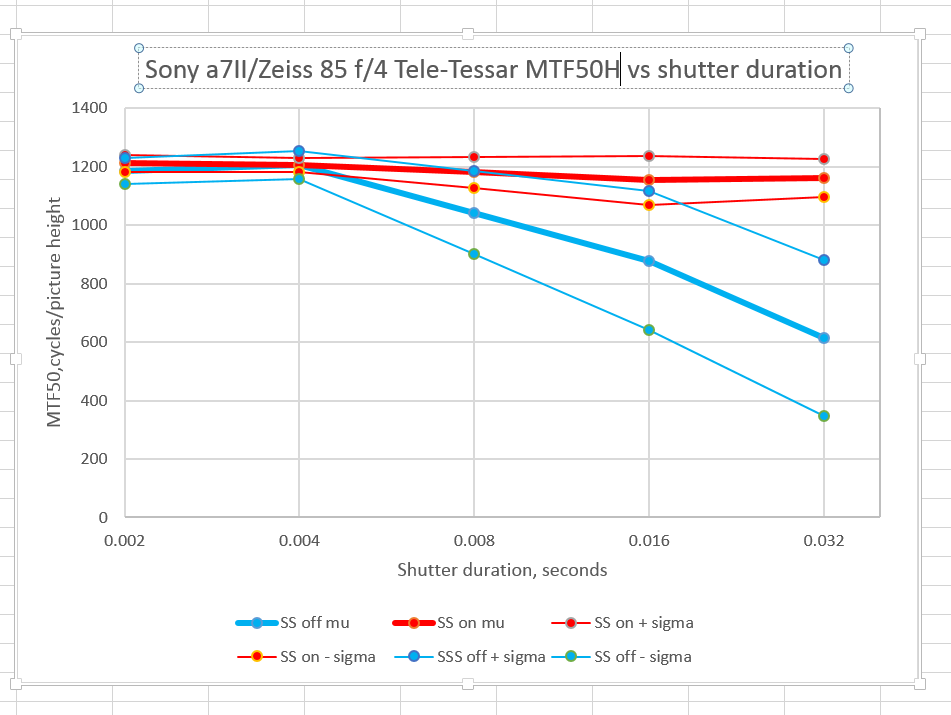Yesterday, although it was hard to tell for sure because of the noise associated with handheld testing, that a lighter lens did slightly better when handheld with IBIS on the Sony alpha 7 Mark II (a7II) at 135mm. For today’s test, I’m pairing the monstrous, heavy Zeiss 85mm f/1.4 Otus with the svelte, dimunitive Zeiss 85mm f/4 Tele-Tessar ZM, both used on the a7II..
The protocol:
- A single Fotodiox LED-200WA-56 daylight balanced flood.
- ISO set to 640, f-stop set to 8,
- Focusing manually using maximum magnification wide open,
- Drive set to single
- EFCS on
- Manual exposure mode.
- “Pete Souza” grip: left palm under base, left fingers bracing the underside of the front part of the lens, elbows against chest, and following this rifle-range release protocol: Inhale, exhale, brace gently, think calm thoughts, squeeze the shutter release, remembering to “pull through”
- Exposure protocol: Light to maximum,, shutter to 1/500 second, make at many more than 16 exposures so you can be sure to have 16 ones where Imatest can find the region of interest (ROI), Turn the light down a stop, make at many more than 16 exposure, until you get to 1/30 of a second.
- Make one series with IBIS on, and one with it off.
- Develop in Lightroom CC 2015 (with ACR 9.0) with standard settings.
- Crop, export as TIFFs, analyze for horizontal edge and vertical edge MTF50 in Imatest version 4.
- Find the files for which Imatest improperly identified the ROI, and replace them with the extra files. This is a manual, fiddly, boring, unpleasant operation.
- Export the results to Excel, crunch the stats, and graph.
These graphs are for the horizontal edges. I ran out of patience before I could analyze the vertical ones.
The vertical axis is the MTF50 for the image: the point where, as the spatial frequency of the subject matter increases, the response on the sensor is reduced to half its very-low-frequency value. The units of spatial frequency are cycles per picture height. Since the a7II has a picture height of 4000 pixels, the highest that the MTF50 should ever get is 2000 cycles per picture height. 1500 is exemplary performance, and not something we are likely to ever see with edges perpendicular to the strong axis of the a7II’s anti-aliasing filter .
The horizontal axis is the shutter duration. The points on the graph correspond to 1/500, 1/250, 1/125, 1/60, and 1/30 second.
The heavy lines are the average for all 16 exposures. The red is with IBIS on, and the blue is with is off (In the legend, I call IBIS “SS”, for SteadyShot). The light lines are the average plus one standard deviation and the average minus one standard deviation. If the statistics for handheld MTF50 turn out to be Gaussian, about two thirds of the images will fall between the two narrow lines. Mu stands for mean. and sigma for standard deviation.
The Otus is slightly worse than the Tele-Tessar at 1/250 second, but it’s probably not statistically significant. I’m discarding the light lens is better theory.
Note that the IBIS is producing nice tight spreads like it did at 180mm, 55mm and the wide angel focal lengths. That’s different from what we saw yesterday with the 135mm lenses.
I wonder if the a7II IBIS (firmware version 1.20 ) has a problem at 135mm


Leave a Reply